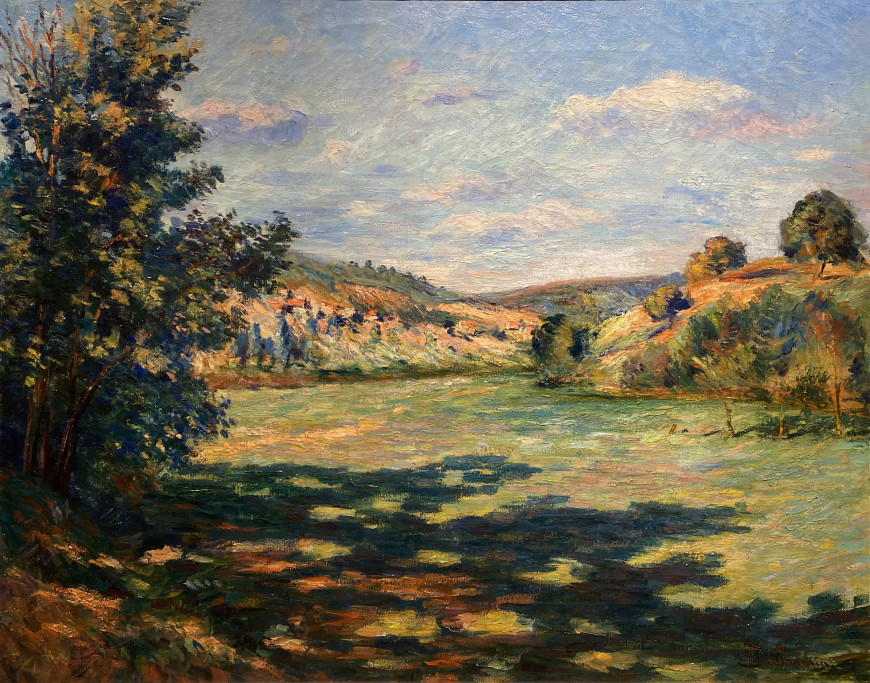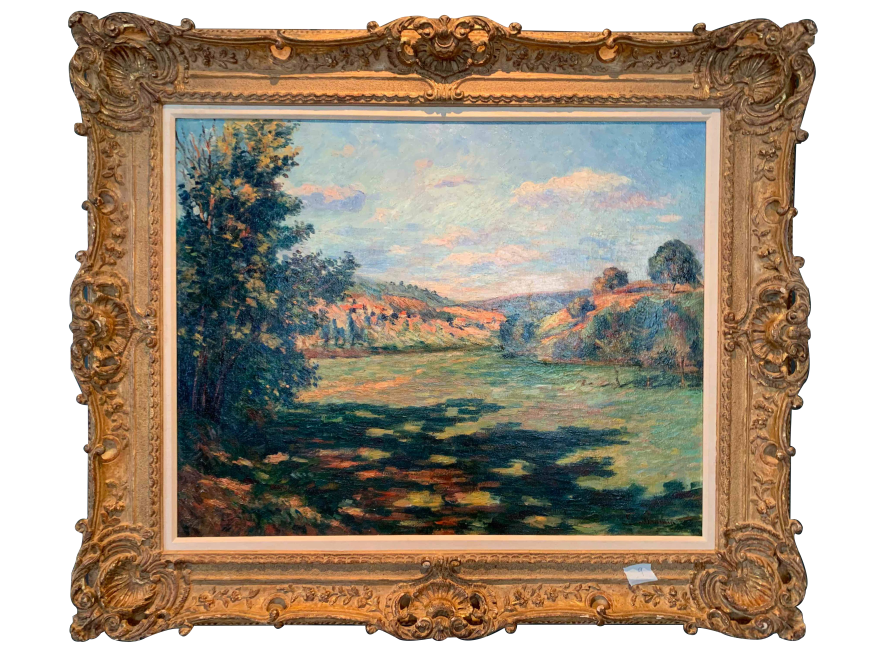-
Œuvres d'art
Jean Baptiste Armand GuillauminLa prairie (The Meadow), 1896 (circa)1841-1927Oil on canvas28 3/4 x 36 1/4 in
73 x 91.9 cmSoldInscriptions
signed, 'Guillaumin' (lower right)Provenance
Galerie Georges Petit, Paris;
Galerie Raphaël Gérard, Paris, 1938;
Stephen Sigaly Galleries, New York;
Collection of Pierre Gabard, Philadelphia;
Wally Findlay Galleries, Inc., March 1975;
Private collection, Montreal.
Expositions
Exposition, Galerie Georges Petit, Paris, as “Dans Les Prés”, undated.
Exposition Armand Guillaumin, Galerie Raphaël Gérard, Paris 1938 #39 , as “La Prairie”.
Philadelphia Museum of Art, April 1965; on loan from Mr. & Mrs Pierre Gabard, Philadelphia.
Documentation
G. Serret et D. Fabiani, Armand Guillaumin, Catalogue raisonné de l'œuvre peint, Éditions Mayer, Paris. illustrated, plate 364The document from Wally Findlay Gallery accompanying this important painting reads;
Armand Guillaumin (1841 - 1927)
As one enjoys the beauty of paintings by Jean-Baptiste-Armand Guillaumin today, it is difficult to realize that as recently as the twenties his work was considered revolutionary. Today his paintings of Rouen, of Crozant, of the quays along the Seine, of the landscapes of the Creuse valley and of areas around Amsterdam seem so serenely poetic in terms of their beautiful color, warm lighting and readily understood subject matter that one finds it hard to think of them as being radical or extreme in any period. Yet, as recently as 1923, his paintings were shown in the Salon des Refusés in Paris along with those of other controversial artists of the period.
In the many articles written of Guillaumin one finds controversy over whether he was technically a pure Impressionist or a painter who held to a style of his own while exerting a strong influence on the development of Impressionism. To a degree this is a matter of definition, and the category into which Guillaumin fits depends on what each critic considers pure Impressionism.
As one examines the work of Guillaumin, there is much in his use of broken color to express effects of light, in his definition of form through color contrast and in his use of color coming through color which is Impressionist in spirit. However, his subjects have greater substance and solidity than the late works of Renoir, Monet and others considered as pure Impressionists.
Guillaumin was born in Paris in 1841 and at the age of twenty-one he began to attend drawing classes in a public night school, while he worked in a shop his uncle owned in Paris. Later he secured a position in the civil service of the city of Paris and for a number of years, in his own words, he “labored like a slave”, spending three nights a week on his job so that he could paint during the day. His family opposed art as a vocation for their son and he was extremely poor. But in 1841 he won 100,000 francs in a bank lottery. After this stroke of good fortune he left his job and devoted himself exclusively to painting.
As early as 1864 Guillaumin worked at the Académie Suisse where he met Pissarro and Cézanne. He was very close friend of artist in the Impressionist movement who have left their mark on the history of art: Cézanne, Monet, Signac, Gauguin, Pissarro, Renoir, Van Gogh, Detroy, were among those whom Guillaumin counted as intimate friends. There are many interesting anecdotes about his association with these artists.
Cézanne and Guillaimin were neighbors on the Quai d’Anjou and often painted together. They likewise took their easels and paintboxes to paint in the park at Issy-les-Moulineaux near Paris. Writing to Duret, Cézanne said of Guillaumin, “He is an artist with a future and a likeable chap of whom I am very fond.”
Signac struck up a fast friendship with Guillaumin working at his side and followed his example more closely than Monet’s in a series of vibrant Paris landscapes. Guillaumin was in fact Signac’s teacher.
Mention is frequently made of Gauguin painting the Tuileries, the bridges and quays of the Seine on his way to and from visits with Guillaumin when the latter occupied Daubigny’s former studio on the Isle Saint-Louis. In fact, Guillaumin’s studio apparently served as a meeting place for many of the important painters of the period. It was there that Pissarro met Signac and Seurat.
During the period when Pissarro made his home at Pontoise, Cézanne and Guillaumin were closely associated with him. Guillaumin was a good friend of Van Gogh who visited him often and was inspired by his forceful colors.
When Guillaumin left Paris in search of new painting sites, he travelled to Brittany, Auvergne and the Côte d’Azur where he painted at Azat and met Detroy. The two artists became friends and Detroy recommend that he visit the Creuse which up to that time was unknown to Guillaumin. As a result, Guillaumin settled at Crozant, painting and developing to the full the riches of his artistic temperament. He once said, “It is possible that there may exist in the world another region as beautiful as Crozant but I cannot believe that there is any region more beautiful.” Guillaumin was a man of simple taste and life in Crozant brought him perfect happiness. In the midst of the infinite charm of that countryside he was able to indulge to the full his love of nature.
Guillaumin shared in the exhibitions of the Impressionists from 1874 on. In that year the innovators of the movement banded together to form the “Société anonyme des artistes peintres, sculpteurs et graveurs.” Skira’s history of Impressionism lists the membership and original organizers of this group as Monet, Pissarro, Renoir, Sisley, Degas, Cézanne, Guillaumin and Berthe Morisot. The group’s first exhibition, held from April 15 to May 15 of the same year in a spacious studio at the corner of the Boulevard des Capucines and the Rue Daunou, unleashed a storm of abuse and ridicule. Supposedly, it was in connection with this exhibition that the then mocking term of “Impressionist” was coined to describe the work of the group.
The third exhibition of the group was held in 1877, and again lists the original eight as major participants. It was in this latter exhibition that the now famous Renoir, “Le Moulin de la Galette,” and Monet’s “Gare Saint-Lazare” were first shown publicly.
By 1881, the year of the sixth exhibition of the Impressionist group, only Degas, Guillaumin, Berthe Morisot and Pissarro were included, as the other members were beginning to go their separate ways. However, in 1882 Durand-Ruel in its gallery in the Rue Saint-Honoré was able to gather together for an important exhibition all the original group with the exception of Degas and Cézanne, and with the addition of Gauguin.
In 1904 Guillaumin went to Holland and painted some of his canvases near Amsterdam. In spite of the weight of his advancing years he painted assiduously, even in his old age, though after 1920, at the insistence of his family, he spent the winters on the Côte d’Azur and each spring he brought back marvelous canvases from that golden area of France.
For some years following eventual public acceptance of Renoir, Monet and other masters, American collectors of the period lost sight of the work of Guillaumin. Few of his paintings were available on the international marker, and little publicity was given to him as an important painter of the period. However, in recent years he has again come into his own and his paintings are more and more highly prized and sought after. He is now not only recognized as the teacher of Signac and a close friend and respected painting companion of many famous artists in whose biographies his name often appears, but as a fine and significant painter in his own right.
Guillaumin’s canvases are paintings of great beauty, both of color and of design. His generous composition, his powerful harmonies, his firm drawings are those of a great painter. His work can stand the severest scrutiny. Although he exhibited with the Impressionists from 1874 on and was a close friend of so many of the great Impressionists, Guillaumin was able to withstand the influences of other men’s work. The ruggedness of his peasant ancestry whose stature and directness he inherited is the firm basis on which he erected the edifice of his art. Few of the landscape painters of the nineteenth century were so straightforward and so free from sentimentality. Even the tone of his pastel portraits and still lifes is that of a virile painter who stands high among the Impressionists. Moreover, towards the end of his life his art came singularly close to that of the Fauves. For example, in many subjects painted in the eighties the rich pungency of his palette is clearly a forerunner of the use of pure color which was later to become a group expression through the Fauves.
Guillaumin surpassed the other Impressionists by the strength of his drawing and the breadth of his stroke and was their equal in charm and delicacy. He is king in the subtle realm of nuance with Monet his only rival. He painted the out-of-doors with great feeling for the ever changing atmospheric effects in nature, whether in open landscape or city areas. In all he painted there is an authentic and joyous lyricism. He saw color in the way the light touched the surfaces of streets, skies, water and people and captured it on canvas. His are paintings which, approached either from a technical point of view or from the standpoint of beauty and interest, are outstanding in the mainstream of nineteenth and twentieth century French painting.
6sur 6

















